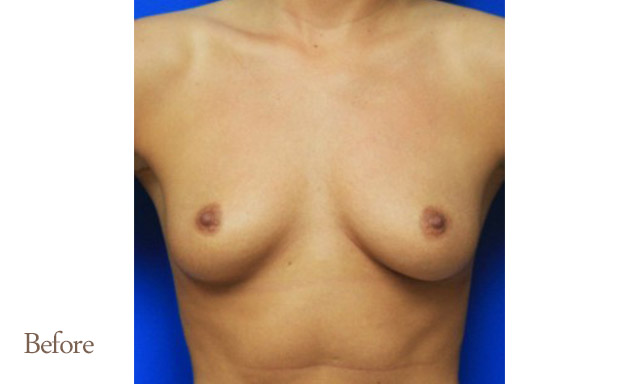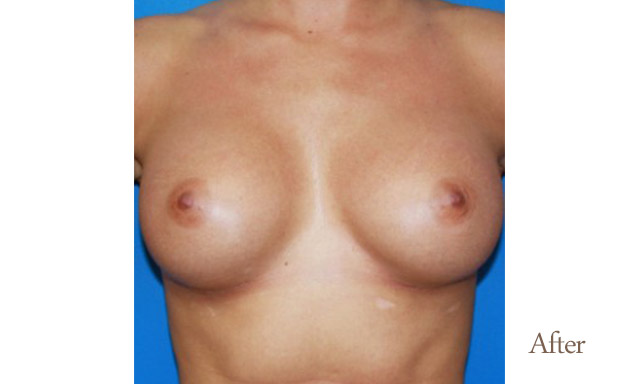Breast augmentation, breast implants, or “augmentation mammaplasty,” is a popular procedure for my patients and is one of the most frequently performed cosmetic surgery procedures in the U.S.
To become a proficient at this technique I spent years performing all types of breast surgery including mastectomy, breast reconstruction, breast lift, and breast reduction. This unparalleled experience in breast surgery gives me the ability to best identify what changes can be safely made in your breast to give you the best possible outcome during your breast implant surgery.
Who Can Benefit?
When considering breast augmentation, you should first determine which breast type you are.

Naturally Small Breasts
This is the most common breast implant category. Typical patients are younger, without pregnancy changes, and have good skin quality.

Post-Pregnancy Breasts
With pregnancy, the breast respond to the hormonal changes to prepare for milk production. This involves increasing the glandular size, the skin envelope and stretching of the internal ligaments. Women with minimal “droop” or ptosis will benefit from standard breast augmentation alone. Those with significant deflation or sagging may require a breast lift, “mastopexy” in combination with a breast augmentation.

Breast Surgery Revision
Given my experience with breast surgery, I perform a significant number of breast revisions each month. The causes for the revision include capsular contracture (scar around the implant), implant rupture or failure, desire to change size, implant displacement or poor position, or to change from saline to silicone implant.

Sagging, Deflated Breasts
As with post-pregnancy breast surgery, breast deflation can benefit from volume increases. Implant size will be dependent on the amount of loose skin. There are time when the implant cannot accommodate enough of the breast and, therefore, a breast lift may be required.
What do you want to accomplish with your augmentation?
Those that know me know that I lean toward a natural look with breast augmentation. To achieve this, I consider several factors
- I generally place the implants below the muscle (subpectoral) or release the lower muscle border (dual plane). This gives the breast a natural, subtle contour. The pectoralis serves to camouflage the implant.
- Silicone implants feel more natural and have less rippling. This is especially true in my thinner patients and those without significant breast tissue (more tissue means the implant is less noticeable).
- My recommendations on size depend largely on the patient’s natural breast size and shape in combination with her anatomy (height, weight, chest measurements, etc.)

Concerns

Full recovery from breast augmentation is roughly two weeks.
Most patients feel tired and sore after breast augmentation surgery, but this usually passes in a day or two. Many patients return to work within the week.
I utilize the Rapid Recovery Method for breast augmentation. I find that the majority of our patients are free from pain medication within 2-3 days with no sacrifice in their outcome.
I placed absorbable sutures and do not use drains. Any post-operative pain, swelling and sensitivity will diminish over the first few weeks.
Scars from breast augmentation incisions will begin to fade in a few months and will continue to fade for months or years. Most are barely noticeable and placed below the breast.
See the Results for Yourself
FAQs
It is very important that you choose the breast augmentation surgery for the right reasons. Breast implants can change the way you feel about your body. Clothes may fit better. You may have more confidence. Some of the more popular reasons to have surgery include:
- Increase confidence and self-esteem
- Breasts that are too small
- Improve your body image
- Make you look better in clothes
- Breasts that are different in size and/or shape
- Restore lost size that occurs from weight loss or breast feeding
- Sagging breast that have lost firmness
- Reconstruct breast after breast cancer or other disease
It depends on certain issues:
- How big your chest is now
- How much breast tissue you have naturally
- The size implant you choose
We help you with this. Breast implant volumes are not well understood by patients due to the variables (ribcage size, chest shape, existing breast volume) that dictate what a given implant size will do. Now, with the Vectra imaging system, you are able to see your results before ever having surgery.
Breast augmentation costs from around $4000 for saline implants to around $5000 for silicone implants. Total cost will depend on what type of implant you use and if other procedures are needed. These costs include surgeon’s fees, OR and anesthesia.
Absolutely! Dr. Spann has been board certified for almost a decade. He holds board certification in both General Surgery and Plastic Surgery.
Dr. Spann has been performing breast implants since 2002. He has performed nearly a thousand of these procedures and is known as one of the foremost breast plastic surgeons in the region.
Dr. Spann has a personal revision rate on breast augmentations of less than 1%. Approximately 20% of his breast procedures are repairs of other surgeons’ work.
This can vary depending on what the issue is. First, no guarantees can (or should) be made by the surgeon. Dr. Spann takes a great deal of pride in ensuring the experience of breast enhancement matches his results. Assuming there is an issue, we will formulate a plan and ensure that the patient is cared for in the best manner.
Yes. We have several staff members who have been operated on by Dr. Spann. He always recommends their candid and honest opinion on any procedures.


